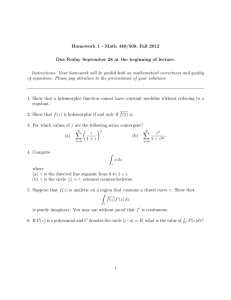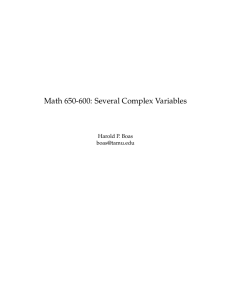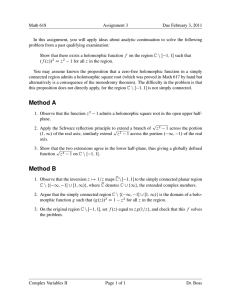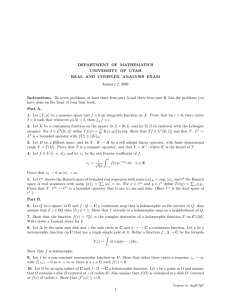radó`s theorem for cr-functions
advertisement
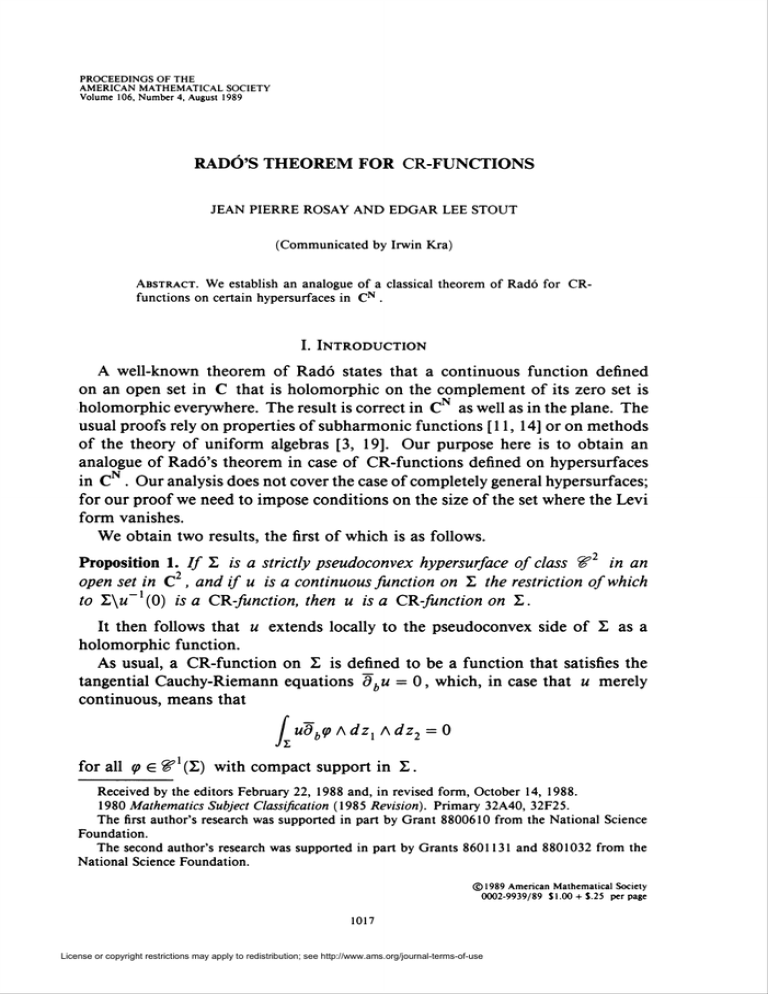
proceedings of the
american mathematical society
Volume 106, Number 4, August 1989
RADÓ'S THEOREM FOR CR-FUNCTIONS
JEAN PIERRE ROSAYAND EDGAR LEE STOUT
(Communicated by Irwin Kra)
Abstract.
We establish an analogue of a classical theorem of Radó for CRfunctions on certain hypersurfaces in CN .
I. INTRODUCTION
A well-known theorem of Radó states that a continuous function defined
on an open set in C that is holomorphic on the complement of its zero set is
holomorphic everywhere. The result is correct in C as well as in the plane. The
usual proofs rely on properties of subharmonic functions [11, 14] or on methods
of the theory of uniform algebras [3, 19]. Our purpose here is to obtain an
analogue of Radó's theorem in case of CR-functions defined on hypersurfaces
in C . Our analysis does not cover the case of completely general hypersurfaces;
for our proof we need to impose conditions on the size of the set where the Levi
form vanishes.
We obtain two results, the first of which is as follows.
Proposition 1. If X is a strictly pseudoconvex hypersurface of class W in an
open set in C , and if u is a continuous function on Z the restriction of which
to I\u~ (0) is a CR-function, then u is a CR-function on I.
It then follows that u extends locally to the pseudoconvex side of X as a
holomorphic function.
As usual, a CR-function on Z is defined to be a function that satisfies the
tangential Cauchy-Riemann equations dbu = 0, which, in case that u merely
continuous, means that
/ udb<pA dz{ A dz2 = 0
Ji
for all tp e & (L) with compact support in I.
Received by the editors February 22, 1988 and, in revised form, October 14, 1988.
1980 Mathematics Subject Classification (1985 Revision). Primary 32A40, 32F25.
The first author's research was supported in part by Grant 8800610 from the National Science
Foundation.
The second author's research was supported in part by Grants 8601131 and 8801032 from the
National Science Foundation.
© 1989 American Mathematical Society
0002-9939/89 $1.00+ $.25 per page
1017
License or copyright restrictions may apply to redistribution; see http://www.ams.org/journal-terms-of-use
1018
JEAN PIERRE ROSAY AND EDGAR LEE STOUT
The proof we give for Proposition 1 is local, so it follows immediately that
in the statement, we can replace the set u~ (0) by u~ (E) for any countable
compact set E. Herbert Alexander has shown recently that, as in the classical
case [18], it is possible to replace w_l(0) by u~l{E), E a compact set of
zero capacity.
To formulate our second result, we need a definition.
Definition. If Z is a hypersurface in an open set in C , a closed subset E of
X will be said to be thin if every closed subset E' of E has a neighborhood
basis {Vj}-X 2 each element of which has piecewise smooth boundary bV.
in £ and these boundaries have (27V- 2)-dimensional area bounded uniformly
in ;.
Examples of such thin sets are sets of finite (2/V - 2)-dimensional measure.
Proposition 2. Let X be a hypersurface of class W in an open subset of C ,
TV> 1, and assume that the set of points in I where the Levi form ofL vanishes,
i.e., all eigenvalues are zero, is thin. Then every continuous function u on X the
restriction of which to I\u~l (0) is a CR-function is a CR-function on all of I..
Our consideration of these matters can be motivated in at least two ways.
The first motivation comes from the study of removable sets in the boundary of
a domain Q in CN: subsets F c bQ such that every CR-function defined on
bQ\F extends holomorphically through the set Q. For this work, we refer to
the papers [7, 8, 9, 20].
Another motivation comes from a general problem about complex vector
fields. Consider on an open subset U in RN a complex vector field L —
X),=i cij(x)d/dXj. Let / be a continuous function on U that satisfies Lf =
0 in the sense of distributions on U\f~ ' (0). Does it follow that Lf = 0
throughout Ul When N = 2 and L is the Cauchy-Riemann operator, the
result is the classical theorem of Radó quoted above, when L = d/dx{ , the
result is true and trivial, and the case that L is the tangential Cauchy-Riemann
operator on a hypersurface in C is the object of this paper. We have no
example of a vector field for which the conclusion fails, and the paper [6] may
suggest that the result is true in general. It seems unlikely that the proofs we
give below shed any light on the general question, for we reduce the problem
for CR-functions to the Radó's theorem on CN .
Our work has the following consequence:
Corollary. If D is a strongly pseudoconvex domain in C with bD of class fê ,
and if the function u is continuous on D, holomorphic on D, then bD\u~ (0)
is connected.
The paper concludes with an application of Proposition
removable singularities for bounded solutions of db.
License or copyright restrictions may apply to redistribution; see http://www.ams.org/journal-terms-of-use
1 to the study of
RADÓ'S THEOREM FOR CR-FUNCTIONS
1019
We shall use the notation that if ATis a compact set in C , then K denotes
its polynomially convex hull. If A c C , bA will denote the boundary of A ,
boundary with respect to C unless otherwise specified.
II. Proof of Proposition
1
We begin with a lemma which is a special case of a result of Slodkowski [15,
Theorem 2.1, p. 365]; for the convenience of the reader, we include a proof.
Lemma. If K c C is a compact set and (?cC
is pseudoconvex, then provided
that K ncf is empty, the set cf\K is pseudoconvex.
Proof. Assume, in order to reach a contradiction, that cf\K is not pseudoconvex. Denote by U the open unit disc in C. According to the Kontinuitätssatz
[21], there exists a change of coordinates in C such that after this change of
coordinates, the unit bidisc U2 does not intersect K, and there exists {q>j}°°=\
>
a sequence of holomorphic functions on C that satisfy \f.\<\
on U and
such that, if we set 0>As) = (s ,<Pj(s)), then 0>j maps U into cf\K, such that
dist(0j{e'e),K)
> S, and such that 4>-(0) tends to some point p0 e K as k
tends to infinity.
If we set fj(zl,z2) = l/(z2 - cp]{zx)), then f. is a holomorphic function
^
_2
defined on a neighborhood of K n U . By the Oka-Weil theorem, f. can be
approximated
uniformly on the set K n U
by polynomials.
Since we have
l/l <max(f5_1,2) on KnbU2 but the supremum of |/| on Kf)U2 tends to
infinity with j, we have a contradiction to the local maximum principle [13,
17, 19], so the proof is completed.
We also need the following more technical fact.
Lemma. Let cf be a bounded pseudoconvex domain in C , and let K be a
compact subset of bcf with the property that K n b(f = K. If cf' = <f\K,
and if u> is a neighborhood of K, then there exists an open set £2 c cf' that
contains the intersection of cf' with some neighborhood of K and that satisfies
the condition that for every function h holomorphic on cf',
sup|A|=
n
sup |A|.
ffTvú
Proof. We consider small open neighborhoods Wx of K and W2 of bcf\K
such that Wxn W2 c co. The domain cf is pseudoconvex, so by the lemma
above, there exists a smoothly bounded, strictly pseudoconvex domain tf, cc
cf' such that <?, d cf'\(W[ u W~2). Let Q = (cf'\cf[) n Wx. The domain Q.
is the intersection of cf' with a neighborhood of K, and the boundary of Q
is included in K U co U Ox . At each point of bSl\(K U co), the boundary of
Q is strictly pseudoconcave when considered from Í2. We shall show that
if h is holomorphic on cf and p e Q, then \h(p)\ < supwn^, \h\. To this
end, consider W^, a small strictly pseudoconvex neighborhood of K such that
License or copyright restrictions may apply to redistribution; see http://www.ams.org/journal-terms-of-use
1020
JEAN PIERRE ROSAY AND EDGAR LEE STOUT
p £ Wl, W3ncfx = 0.
Let Qp = ÇÎ\W3. The boundary of Qp consists of
points that lie in co or at which the boundary of Í2 is strictly pseudoconcave:
The part of the boundary of Q outside co coincides locally with bcfx or with
bW}. Since no local maximum can be attained a strictly pseudoconcave point,
we get that for every function h holomorphic on cf'
\h(p)\ < sup|/z| < sup \h\ < sup \h\.
Sip
SipHo)
@'r\w
We turn now to the proof of Proposition 1. The problem is purely local,
so as strongly pseudoconvex hypersurfaces are strictly convex in suitable local
coordinates, it suffices to establish the following version of the result.
Proposition l'. Let D be a bounded, strictly convex domain in C with bD
of class & , and suppopse that 0 e D. Let cf = D n {Rez, > 0}, and let
(bcf)+ - bDn{Rezx > 0} . If u is a bounded continuous function on (bcf)+ the
restriction of which to (bcf)+\u~\0)
isa CR-function, then u has a continuous
extension to (bcf)+ucf that is holomorphic on cf, whence u isa CR-function
on all of (bcf)+.
Proof. Let K be the compact set given by
K = {ze bcf: Re zx = 0 or u(z) = 0},
and let cf' —cf\K. We need to know that every CR-function v on bcf\K has
a continuous extension, v into cf\K that is holomorphic on cf'. This fact is
essentially contained in the literature; we discuss the point in the Appendix at
the end of the paper. We have that |i|^. - < \v\b(f,K .
Let w, be the restiction of u to bcf\K, and denote by w, the holomorphic
extension of ux to cf\K. To begin with, we shall show that if {zJ}J=x is
a sequence of points in cf' that tends to some point p e K n {Rez, > 0},
then w,(z;) tends to 0. To see this, fix y/, a function holomorphic on some
neighborhood of D that peaks at the point p so that y/(p) = 1 and |^| < 1
on D\{p} . Let e > 0, and fix k large enough that \y/ u\ < s on (bcf )+ . Such
a k exists because u(p) = 0. We have \y/ ux\ < s on cf', as the remark above
implies. Since y/(p) = 1, we get that limsup^^
|w,(z;)| < e , and we see that
ux does tend to zero at the points of K in {Rez, > 0} as claimed.
We now show that if {z7}. œ is a sequence of points in cf' that converges
to a point p e K ncf, then ux{zj) tends to zero. Let e > 0, and fix A > 0
such that e~AKep'/'isup{fl \üx\ < e. Let co be a neighborhood of K such that
for every (z,, z2) e cf' n co, either Rez, < Re/?,/2 or \eAziux(z)\ < e, which
is possible because Ö, has limit zero at K n {Rez, > 0}. The second lemma
provides an open"5et Í2 c cf' that contains the intersection of cf' with some
neighborhood of K and on which we have
sup
(z, ,22)er>
\e
ux\ < sup \e
rf'nw
License or copyright restrictions may apply to redistribution; see http://www.ams.org/journal-terms-of-use
ux\.
RADÓ'S THEOREM FOR CR-FUNCTIONS
For sufficiently large j,
1021
zJ = (z\, zJ2)e Í2, and Re z\ > 3 Rep, /4, so we get
|«,(z )| < Max(e
sup|«,|,e)
< e,
and the assertion follows.
Finally, we define the function ü by w = ux(z) on cf' and u(z) = 0 if
z € <f\<f '. It follows from our remarks above that « is a continuous extension
of u to (bcf )+ u cf that is holomorphic on cf by virtue of the classical version of Radó's theorem. This completes the proof of Proposition 1' and so of
Proposition 1.
III. Proof of Proposition
2
The proof breaks into two parts. Denote by E the set of points in Z where
the Levi form of Z vanishes. We will first prove that u, as given in the statement of Proposition 2, is a CR-function on 1\E. In terms of holomorphic
extensions, this is related to the fact that one can get holomorphic extensions
from holomorphic extensions along slices. Here, however, we shall work directly
in terms of the CR-structure. Fix p e 1\E, and let p be a defining function.
We may choose coordinates so that p = 0 and (dp/dzx)(0) ^ 0. Denote by
T¿ the complex tangent space to Z at 0. If we orient Z properly, the Levi
form of Z, which we shall denote by Jz^., has at least one positive eigenvalue.
Let t = (t2, ... ,tN) be a vector in T0C that satisfies 2^(t) > 0. Let M be
the two-dimensional subspace spanned by the vectors t and (1,0, ... , 0). We
foliate a neighborhood of 0 e C by leaves parallel to M, and we apply Proposition 1 to the intersection of Z with each of the leaves. * This shows that if
we set
with a = -(dp/dz^Z^tjdp/dZj,
which satisfies a(0) = 0, then J?\(u) = 0
on a neighborhood of 0 in Z. We can replace t by another vector t' e Tq
close enough to t. Doing so shows that for a set {Lt,} of generators for the
tangential Cauchy-Riemann equations, Lt, u = 0 on a neighborhood of 0 e Z.
To complete the proof of Proposition 2, we deal with the set E. Set E' —
{z e E:u(z) = 0}. By the hypothesis and what we have done above, u is
continuous on Z, the restriction of u to T\E' is a CR-function, and u = 0
on E'.
For every e > 0 there exists a neighborhood E£ of E' in Z on which
\u\ < e and which is bounded (in Z) by a piecewise smooth hypersurface in Z
of (2./V-2)-dimensional area bounded independently of e. Set u£ = uxe where
* There is a detail to be dealt with here, viz., to know that the restriction of a CR-function on
Z to the interesection of £ with a transverse, two-dimensional subspace is again a CR-function.
For continuously differentiable functions, the result is clear. The case of continuous CR-functions
is correct as may be seen by invoking the approximation theorem of Baouendi and Trêves [ 1]. An
alternative, much simpler route to the same conclusion is given in the forthcoming paper [10].
License or copyright restrictions may apply to redistribution; see http://www.ams.org/journal-terms-of-use
1022
JEAN PIERRE ROSAY AND EDGAR LEE STOUT
Xe is the characteristic function of Ee. If L is a tangential Cauchy-Riemann
operator defined on Z, then when we apply L to u£, we get only a jump term
carried by bE£, the boundary of EE in Z: Lue = uh£da£ where da£ is the
area measure on bE£, and hE is bounded in terms of the coefficients of L.
This is clear, for in terms of local coordinates (Çx, ■■■,Ç2n_x) on Z, we have
that {d/dÇj)xe is the measure induced by the form
(-1)j+Xa---a^a-a^_,.
If we let e approach zero, we get Lu = 0, as desired, since \u\ < e on bE£.
This completes the proof.
If we use the fact that on Levi flat parts of Z, Proposition 2 is an immediate
consequence of the classical theorem of Radó, it would be enough to assume
that the boundary of E in Z is thin.
IV. An application
We end the paper with an application to the theory of removable singularities
for bounded functions. Let D
■y be a strongly pseudoconvex domain in C ,
N > 1, with bD of class W . Let / be a function that is continuous on
D and holomorphic on D. We denote by Zb (/) the set of points in bD
where / vanishes. This is a subset of bD with zero area, but it may have
Hausdorff dimension IN - 1 as examples of Stensones [2, 16] show. Let g
be a bounded measurable function on bD that satisfies the tangential CauchyRiemann equations in the weak sense on bD\Zb(f).
We shall show that in
fact g satisfies weakly the tangential Cauchy-Riemann equations on all of bD,
and thus, that g is the boundary value function of a function bounded and
holomorphic on D. Briefly put, Zb(f) is a removable set for bounded weak
solutions of db on bD.
Consider first the case that the function g is continuous outside Zb(f). The
function h defined to be zero on Zb(f) and defined to be fg on bD\Zb(f)
satisfies the tangential Cauchy-Riemannian equations in bD\Zb(f) and is continuous on bD. As it vanishes on the set Zb(f), our version of Radó's theorem
implies the existence of a function H holomorphic on D with the continuous
boundary values h . The function G = Hf~ ' is meromorphic on D and assumes continuously the boundary values g almost everywhere on bD. We
shall show that, in fact, the function G is holomorphic and bounded.
To see this, introduce the set M6-{ze
D: \f(z)\ = S}, and notice that it
is fibered by the codimension one subvarieties /- (Se' ) n D. In addition, let
D6 = D\{z: \f(z)\ <S}. We have that bDs = M¿ U T if Y = bD\{z: \f(z)\ <
S}. As Ms is fibered by analytic varieties of positive dimension and as g
is bounded uniformly on bD, say \g\ < 1, we have \G\ < 1 on Ds by the
maximum principle. This bound is correct for all choices of S, so G is seen
to be bounded on D\f~ (0). Consequently, G extends to be holomorphic on
License or copyright restrictions may apply to redistribution; see http://www.ams.org/journal-terms-of-use
RADO'S THEOREM FOR CR-FUNCTIONS
1023
all of D, and it is also bounded. This disposes of the special case of the result
in which g is assumed to be continuous.
Note that there is an alternative, functional-analytic way to see that the function G is bounded. It is bounded because every homomorphism from the
algebra of bounded CR-functions defined on bD\Zb(f), equipped with the
supremum norm, into C is of norm one. From this, |G| < supiD>z (f) \g\.
The case that g is merely bounded reduces immediately to the case just
considered as follows. The strict pseudoconvexity of D assures us that the
function g extends locally into D from every point in bD\Zb(f).
Thus,
if we denote by Z), a domain obtained from D by pulling bD in slightly
along bD\Zb(f) and leaving it fixed along the set Zb(f), then Z>, is again
strongly pseudoconvex, and the function g extends holomorphically into the
crescent shaped domain D\DX as a bounded function, say gx . We can arrange
so that, in fact, gx is continuous on bDx\Zb(f).
Apply the result we have
obtained for continuous functions to the restriction gx\(bDx\Zb(f)) to find
that gx continues holomorphically into Dx as a bounded function. We may
conclude that the function g continues through D as a bounded holomorphic
function, as we wished to show.
Appendix
In the notation used in the proof of Proposition l', we are to see that each
CR-function v on bcf\K has a continuous extension, v, to cf\K that is
holomorphic on cf'. There are two ways to see that this is so. First, let W
denote a component of cf'. Then b W = Q u E, where Í2 is an open set in bD
and E = bWC\K. The set E has the convexity property that given z e W\E,
there is a polynomial p with
p(z)
= \>\\p\\E,
for E c K, and W\E n K = 0. Moreover, b W\E = Q is connected, as
follows from Alexander's theorem [0]: If X c ¿BN is compact, then bBN\X
and BN\X have the same number of components. The proof Alexander gives
for this applies equally well to an arbitrary convex domain in place of the ball.
Granted the connectedness of Q, our function v continues holomorphically
into W by [7, Theorem 1]. As this is true for every component of cf', we have
the desired extension.
An alternative way to obtain what we need is to give a direct proof of the
following way.
Proposition 3. Let U be a bounded open set in C , N >2. Let K c bU be a
compact set such that U is strictly pseudoconvex at every point of the set b U\K,
which we take to be a smooth manifold of class C . Assume that KnbU = K.
Then every continuous CR-function on bU\K has a continuous extension to
(bU\K)u(U\K)
that is holomorphic on U\K.
Here again, K denotes the polynomially convex hull of the set K .
License or copyright restrictions may apply to redistribution; see http://www.ams.org/journal-terms-of-use
1024
JEAN PIERRE ROSAY AND EDGAR LEE STOUT
Proof. Let / be a continuous CR-function on bU\K. By the strong pseudoconvexity of bU\K, / extends locally into U along bU\K. If x is an
infinitely differentiable function on C \K with x identically one on a neighborhood of bU\K and identically zero away from bU\K, the function /*
given by /* = xf on the domain of /, 0 on U n {x = 0} is a smooth
function on U that agrees with / near bU\K.
Define a (0,l)-form G on CN\K by letting G = df* on c/,G = 0 on
CN\(K U U).
The form G is smooth and is d -closed. We shall show that there is a function
u defined on C \K with suppw c {z e C :\z\ < R} for some R such that
du = G on CN\K.
Notice that C \(K U U) cannot have any bounded component. Indeed, if
Y were such a component, bY would be strictly pseudoconcave at every point
of bY\K, and therefore for every polynomial P one would have: supy |P| <
supjç \P\, clearly a contradiction with the definition of K. Then, Proposition
3 follows immediately. As u is holomorphic off K U U we have u = 0 on
b U\K, and thus /* - u gives the desired extension.
The existence of the function u is a consequence of the following fact:
Lemma. Let X be a compact polynomial convex subset of C , N > 2. Given
a smooth d-closed (0,l)-form G on W - CN\X, G with bounded support,
there is a function u defined in W with bounded support that satisfies du = G
on W.
Proof. Begin -by fixing a strongly pseudoconvex neighborhood
Q of X with
b£l
—
N
smooth and Q, polynomially convex. We will first solve du = G on C \il.
Denote by v a smooth function on C that satisfies dbv = G on bQ.. For
JV > 3, this is immediately possible [4]. For N - 2, more effort is required
[4, 12]; we must verify that
/
hG AdzxAdz2 = 0
for every smooth function h that is holomorphic on Q. However, by virtue of
the assumption of polynomial convexity and the Oka-Weil theorem, it suffices
to verify this condition for polynomials h . If h is a polynomial, we can use
Stokes's theorem to write for large R > 0 that
/
JbSi
hGAdzxAdz2=
hG AdzxAdz2 = 0.
J\A=R
Thus, the desired v exists independently of the value of N.
Granted that there is a smooth function « on C with dbv = G on bil,
it follows [12, Remark, p. 125] that there is a smooth function on C , again
denoted by v , with dv = G on bQ.
It follows that we can define a continuous form G* with compact support
on CN by taking G* to be G on CN\Q and to be dv on Q. The form G*
License or copyright restrictions may apply to redistribution; see http://www.ams.org/journal-terms-of-use
RADÓ'S THEOREM FOR CR-FUNCTIONS
1025
is continuous, and it is d -closed in the sense of currents: If 6 is a smooth
(N, N - 2)-form on CN with compact
pact support, then
Jc*
<30AC7= O,
for this integral is the sum
I 1)0AG*+ f
Ja
JcN\n
d6AG\
which vanishes by Stokes's theorem. It follows that there is a compactly supported continuous function u that is smooth off bQ. and that satisfies du = G*
in the sense of distributions.
If we choose a sequence {ß,},=1
of domains like Q with Q, dd Q2 dd
■■• and H Oj■= X, and if we let w satisfy du = G on Q , we can define
u on C \X by u(z) = uiz)
connected set C \fl.
for large y.u- - w +, is holomorphic in the
and has bounded support. Thus, u = uj+x throughout
CN\Qj, and u is well defined. It satisfies d u = G and CN\K.
The proof just given for Proposition 3 follows closely the lines of the proof
of Theorem 2.3.2' of [5].
References
0. H. Alexander, A note on polynomial hulls, Proc. Amer. Math. Soc. 33 (1972), 38-391.
1. M. S. Baouendi and F. Trêves, A property of the functions and distributions annihilated by a
locally integrable system of complex vectorfields, Ann. Math. (2) 113 (1981), 387-421.
2. J. E. Forroess and B. Stensenes, Lectures on counterexamples in several complex variables,
Princeton Univ. Press, Princeton, N.J., 1987, 247.
3. T. W. Gamelin, Uniform algebras, Prentice-Hall, Englewood Cliffs, 1969, xiii+257.
4. G M. Henkin, 77!? Lewy equation and analysis on pseudoconvex manifolds, Russian Math.
Surveys(3) 32 (1977), 59-130.
5. L. V. Hörmander, An introduction to complex analysis in several complex variables, Van Nos-
trand, Princeton, N.J., 1966.
6. P. H. Krief, Sur les formes différentielles fermées à coefficients differentiables mais non con-
tinûment differentiables,Ann. Polon. Math. XLIV (1984), 201-207.
7. G. Lupacciolu, A theorem on holomorphic extension of CK-functions, Pacifie J. Math. 124
(1986), 177-191.
8. G. Lupacciolu, Holomorphic continuation in several complex variables, Pacifie J. Math. 128
(1987), 117-125.
9. G. Lupacciolu, Some global results on extensions of CR-objects in complex manifolds, to
appear.
10. G. Lupacciolu and E. L. Stout, Removable singularities for db , to appear.
U.R.
Narasimhan,
Several complex variables, Univ. of Chicago Press, Chicago and London,
1971,x+174.
12. J.-P. Rosay, Equation de Lewy-résolubilité globale de l'équation db = f sur la frontière de
domaines faiblement pseudo-convexesde C2 {ou de C), Duke Math. J. 49 (1982), 121-128.
13. H. Rossi, The local maximum modulus principle, Ann. Math. (2) 72 (1960), 1-11.
License or copyright restrictions may apply to redistribution; see http://www.ams.org/journal-terms-of-use
1026
JEAN PIERRE ROSAY AND EDGAR LEE STOUT
14. W. Rudin, Function theory in the unit ball of C , Springer-Verlag, New York, 1980, xiii+436.
15. Z. Slodkowski, Analytic set-valuedfunctions and spectra, Math. Ann. 225 (1981), 363-386.
16. B. Stensenes (Henricksen), A peak set of Hausdorff dimension 2n-l
for the algebra A{3!) in
the boundary of a domain 9! with 'W00-boundaryin C , Math. Ann. 289 (1982), 271-277.
17. G Stolzenberg, Polynomially and rationally convex sets, Acta Math. 109 (1963), 259-289.
18. E. L. Stout, A generalization of a theorem of Radó, Math. Ann. 177 (1968), 339-340.
19. E. L. Stout, The theory of uniform algebras, Bogden and Quigley, Tarrytown-on-Hudson,
1971,
x+509.
20. E. L. Stout, Analytic continuation and boundary continuity of functions of several complex
variables, Proc. Roy. Soc. Edinburgh Sect. A 89 (1981), 63-74.
21. V. S. Vladimirov, Les Fonctions de Plusieurs Variables Complexes, Dunod, Paris, 1971,
xv+338.
Department
of Mathematics,
University
of Wisconsin, Madison, Wisconsin 53706
Department
of Mathematics,
University
of Washington,
License or copyright restrictions may apply to redistribution; see http://www.ams.org/journal-terms-of-use
Seattle,
Washington
98195

